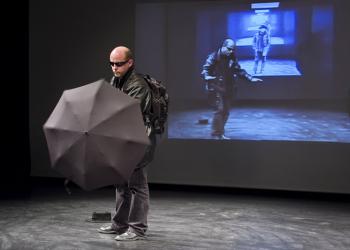The exhibition Tomáš Ruller (1957*) in Communication Space presents work from the artist's oeuvre from 2007 through the present. Here we find the author's solo projects, the results of his international cooperation within the Black Market Performance Group, Open Situation or Groundworks, or performances at the In'Fr'Actions Venice Biennale and Séte, Guangzhou Live, Crossroads Live Action Gotteborg, Malamut, and others.
What then has Tomáš Ruller done in the last six years? Performers when asked a similar naturally posed question answer in a more complicated manner than painters or sculptures. We often consider performers' documentation to be their work. It is what we are most often confronted with, in the form of, most often, artistically impressive photographs, videos or preserved props and objects. If documentation were the performer's goal, he or she would probably become a photographer, filmmaker or sculptor. The performer, however, foremost offers mutual experience. He or she most often does something we could do ourselves but would never think to do. The performer does it for us, offers their experience as a cathartic tool to all who are present.
But how can this presence be transfered to the gallery? The genre of retrospective of performance artists has become established in the last decade and generally has a tendency towards two extremes: One places meticulous attention to period documentation, oftentimes incomplete and factually misleading. Within the other field we find attempts at reenactments of historical performances, for the most part in another context with very varying results. The dilema of how to relay, through the use of various media, is present in the art of performance from the beginning of its historical inception. Tomáš Ruller has reflected this himself at the very least since the early 1980s. At that time he began to use photography, but also video documentation, as well as creating media performance work utilizing various forms of mediation.
The typology of different forms of documentation is withheld here in the manner in which the exhibition at the Školská 28 Communication Space is installed. In one section of the gallery photo-documentation has been placed, in the other, a selection of videos. Photography has the ability to capture the essence of performance. They have their artistic value, which may not be identical with the intention of the performance. They lack a time frame and in the worst case may seem like pages from a calendar or costume swatches. Video is able to capture what photography cannot: time and interaction with the environment. For example in the background of the Open Situation paintball event at Wensecslas Square we can see a union manifestation taking place, which eventually enters directly into the on-going festival.
But is video time the same as performance time? Weighing Waiting Weight from 2010 challenges this in an interesting way. The artist stood on a scale for eight hours recording his weight loss caused by the expansion of energy. The seven-hour video record is a kind of 1:1 documentation, conveying the real progress of the visible part of the event, which ends in darkness. Some works on display are presented both in photographs and on video, enabling us to clearly percieve the differences in their properties. Ghost in the photograph looks like a real icon of a mysterious god or alien. The video however reveals, in addition, that the wind constantly changed the shape of this being while giving off a menacing sound. There, where the zone of photographs and videos in the gallery touch, Tomáš Ruller on the occasion of the opening performs a live event related to his projects IN IN and Peace for Grotowski. In the piece Ruller and his colleague Habib Kheradyar Zamani in Los Angeles enter into a dailogue via streaming. There is a delay, however, it falls apart into sequences of mutual images relating to themselves, thematizing virtul and actual communication and intercultural dialogue. The term 'live event' is not really appropriate here as the content is precisely that which is conveyed and its shift, the highlighting of the spatial distance and the technological medium. As the authors themselves profess "meeting on the Internet moves between real and virtual space, present and passing time, the creation and the disappearance of an image..."
How has Tomáš Ruller's work changed over the last years? At first glance only slightly. Perhaps it is more civil, dispenses with large symbols, at moments we discover a previously hidden sense of humor. During his performances Ruller continues to be often motionless and absorbed in the given moment. His slow and stylized movements are reminiscent of the clumsy choreography of a robot or soldier. From behind his sunglasses he appears not to notice the onlooker, he is incalculably concentrated and provokes with his indifference. He reminds one of a guard, a living sculpture in front of a palace, who is more the symbol of a warrior than a real guard. When carefully observing the documentation however, it is clear that in reality Ruller's entire performance is based on careful interaction with the environment and in fact on improvisation.
As opposed to his past work Ruller is moving from static installation toward the means of theater. When possible he attempts to encroach on the audience outside of the gallery setting, oftentimes literally leaving the gallery space. At the same time we find works here which enter into a dialogue with art or the art world. The ritual-symbolic, sensory impressive, and in a wide sense ecological motif of purification is still one the the strongest we find here. Perhaps society and its life has become more of a point of interest for him. Cooperation is an established motif in Ruller's work, whether directly or through the aid of technological media.
Tomáš Pospiszyl

